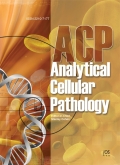Authors: Visscher, Daniel W. | Gingrich, Debra S. | Leon‐Armin, Carmen | Tabaczka, Pamela | Crissman, John D.
Article Type:
Research Article
Abstract:
Two‐color, multiparametric synthesis phase fraction (SPF) analysis of cytokeratin‐labeled epithelial cells was flow cytometrically performed on both benign (SPFb) and malignant tissue samples (if available, SPFt) from 132 mastectomy/lumpectomy specimens. These data were then correlated with clinicopathologic features, including (1) tumor differentiation, (2) the proportion of tumor comprised of duct carcinoma‐in situ (DCIS), and (3) the histology of accompanying benign breast tissue, classified by predominant microscopic pattern as intact, normal terminal duct lobular units (NTDLU, 34% of cases), atrophic (AT, 33% of cases), proliferative fibrocystic (PFC, 26% of cases), and non‐proliferative fibrocystic (NPFC, 7% of cases). SPFt was inversely correlated
…with extent of DCIS (DCIS =0{-}20 % tumor volume – 12.7% mean SPFt, vs. DCIS > 20% tumor volume – 6.4% mean SPFt, p=0.001 ). SPFt also correlated with the histology of background benign breast tissue (NTDLU – 14.8% mean SPFt vs. AT – 6.9% mean SPFt vs. PFC – 12.7% mean SPFt, p=0.05 ) but it did not correlate with patient age or SPFb (overall mean =0.73 %). SPFb was correlated with patient age ({>}56 yr – 0.59% mean SPFb vs. {<}56 yr – 0.84% mean SPFb, p=0.02 ), with background histology (NTDLU – 1.1% mean SPFb vs. AT – 0.43% mean SPFb vs. PFC – 0.70% mean SPFb, p<0.02 ) and with the grade of the neoplasm (well/moderate – 0.58% mean vs. poorly differentiated – 0.85% mean, p=0.04 ). Patients having a background of PFC were significantly older than patients with a background of NTDLU (45.2 yr vs. 60.2 yr, p=0.01 ). We conclude: (1) breast carcinomas arising from a background of more actively cycling pre‐involutional or proliferative fibrocystic epithelium have a greater proliferative fraction than tumors arising from atrophic epithelium, implying that the differentiation status of target cells may impact the effect(s) of tumorigenic events; (2) PFC may represent delayed, abnormal or interrupted involution rather than a hyperproliferative state relative to NTDLU, suggesting that it facilitates neoplasia by extending the period of exposure to promoter agents such as endogenous hormones, and (3) lower SPFt in breast neoplasia with more abundant “residual” DCIS may reflect a lengthier pre‐invasive disease interval due to intrinsically less aggressive phenotype.
Show more
Keywords: Synthesis phase fraction, fibrocystic disease, flow cytometry, breast carcinoma
Citation: Analytical Cellular Pathology,
vol. 17, no. 3, pp. 167-175, 1998
Price: EUR 27.50





